Challenges and Cost Management in Civil Construction
VerifiedAdded on 2023/06/10
|14
|3563
|297
Report
AI Summary
This report delves into the challenges faced by commercial building contractors during project execution, particularly focusing on cash flow issues. It highlights the importance of sufficient cash flow for various aspects of construction, including labor, overhead, and material expenses. The report explores factors contributing to cash disparities, such as supplier problems, financial issues, and communication breakdowns. It further examines cost management activities, including estimation, scheduling, data collection, and cost control. The report also covers the effectiveness of general cost management, including planning, estimation, budget determination, and cost control. It also discusses the importance of resource management and human resource management in construction projects, including the utilization of resources, conflict resolution, and ensuring the availability of skilled workers. The report also addresses cost value reconciliation and its role in monitoring project profitability and early warnings concerning costly contracts.
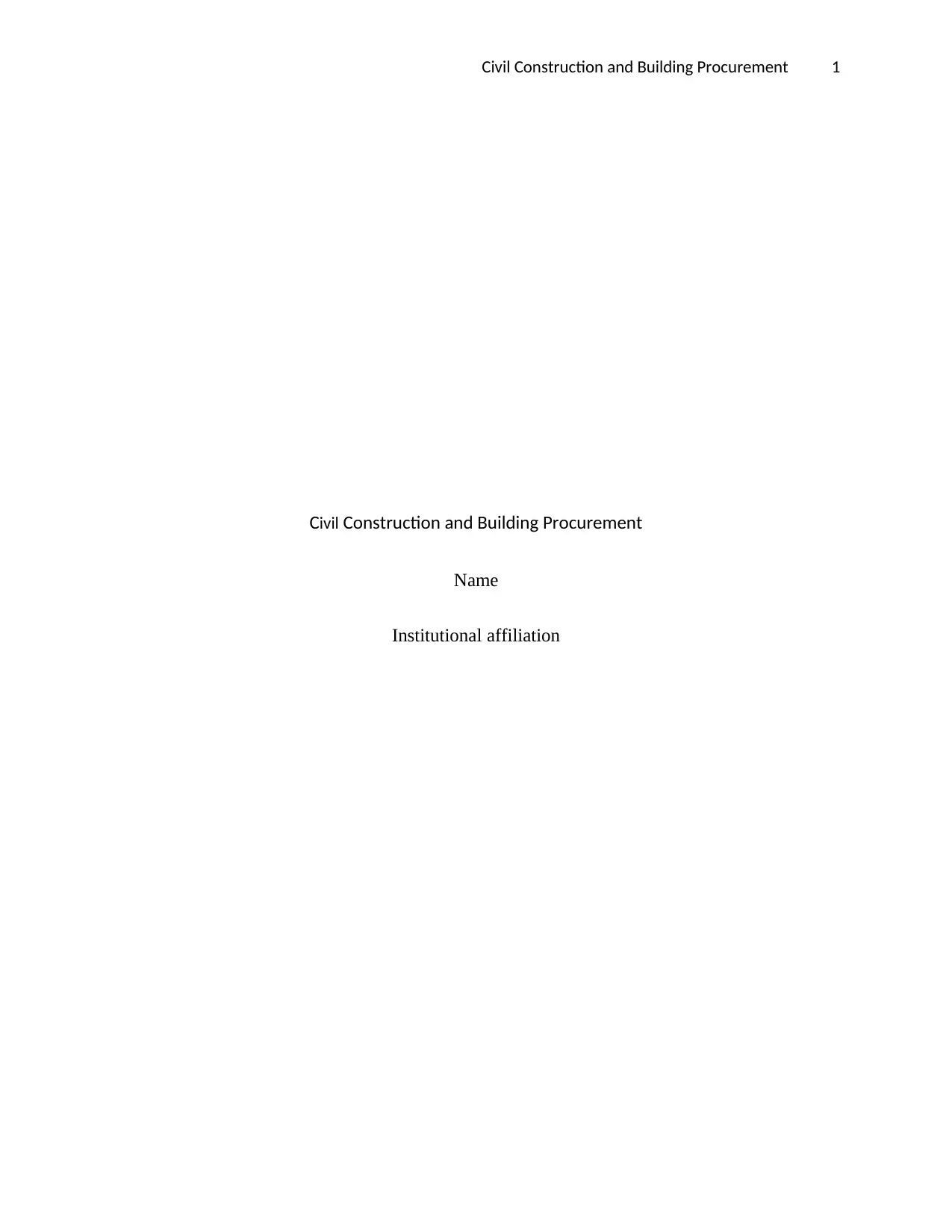
Civil Construction and Building Procurement 1
Civil Construction and Building Procurement
Name
Institutional affiliation
Civil Construction and Building Procurement
Name
Institutional affiliation
Paraphrase This Document
Need a fresh take? Get an instant paraphrase of this document with our AI Paraphraser
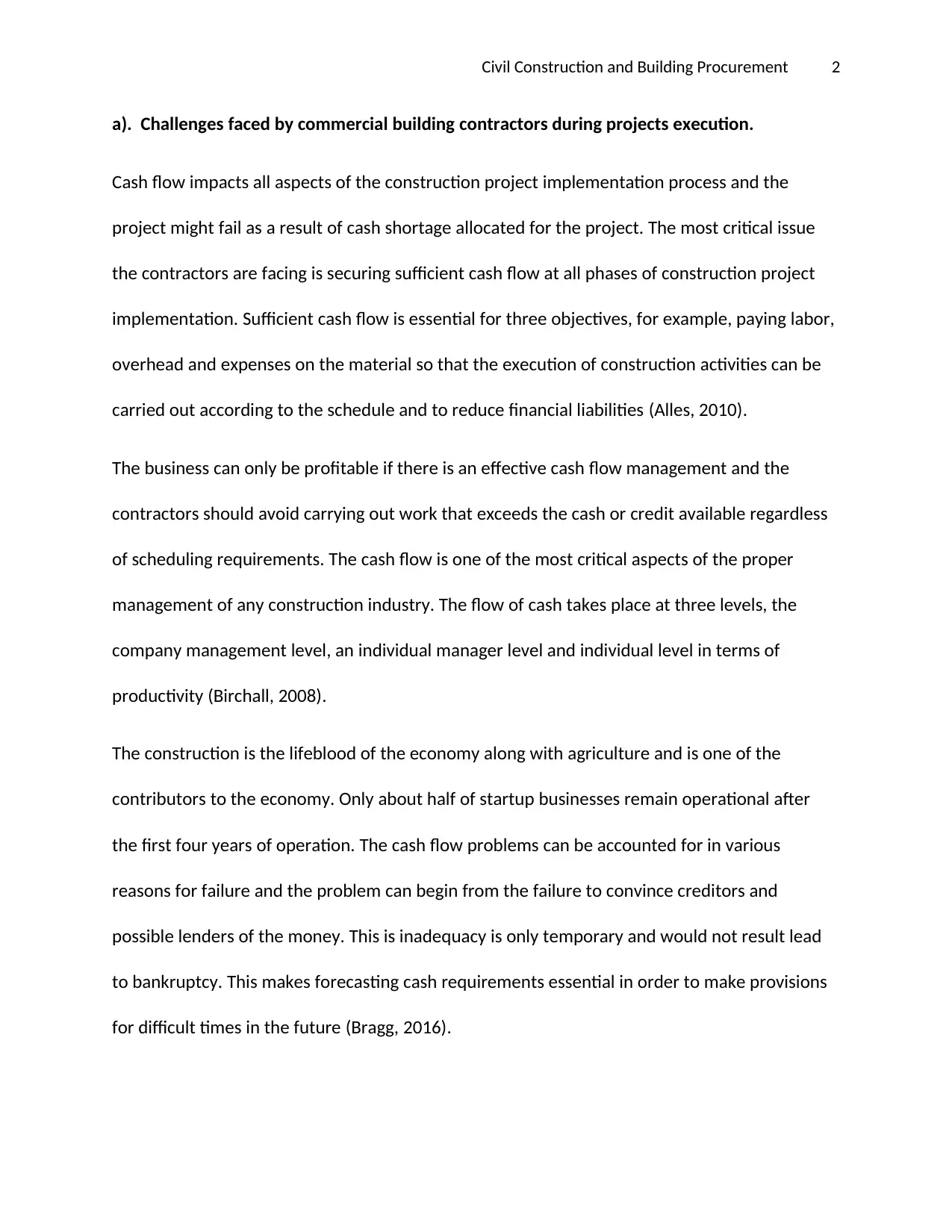
Civil Construction and Building Procurement 2
a). Challenges faced by commercial building contractors during projects execution.
Cash flow impacts all aspects of the construction project implementation process and the
project might fail as a result of cash shortage allocated for the project. The most critical issue
the contractors are facing is securing sufficient cash flow at all phases of construction project
implementation. Sufficient cash flow is essential for three objectives, for example, paying labor,
overhead and expenses on the material so that the execution of construction activities can be
carried out according to the schedule and to reduce financial liabilities (Alles, 2010).
The business can only be profitable if there is an effective cash flow management and the
contractors should avoid carrying out work that exceeds the cash or credit available regardless
of scheduling requirements. The cash flow is one of the most critical aspects of the proper
management of any construction industry. The flow of cash takes place at three levels, the
company management level, an individual manager level and individual level in terms of
productivity (Birchall, 2008).
The construction is the lifeblood of the economy along with agriculture and is one of the
contributors to the economy. Only about half of startup businesses remain operational after
the first four years of operation. The cash flow problems can be accounted for in various
reasons for failure and the problem can begin from the failure to convince creditors and
possible lenders of the money. This is inadequacy is only temporary and would not result lead
to bankruptcy. This makes forecasting cash requirements essential in order to make provisions
for difficult times in the future (Bragg, 2016).
a). Challenges faced by commercial building contractors during projects execution.
Cash flow impacts all aspects of the construction project implementation process and the
project might fail as a result of cash shortage allocated for the project. The most critical issue
the contractors are facing is securing sufficient cash flow at all phases of construction project
implementation. Sufficient cash flow is essential for three objectives, for example, paying labor,
overhead and expenses on the material so that the execution of construction activities can be
carried out according to the schedule and to reduce financial liabilities (Alles, 2010).
The business can only be profitable if there is an effective cash flow management and the
contractors should avoid carrying out work that exceeds the cash or credit available regardless
of scheduling requirements. The cash flow is one of the most critical aspects of the proper
management of any construction industry. The flow of cash takes place at three levels, the
company management level, an individual manager level and individual level in terms of
productivity (Birchall, 2008).
The construction is the lifeblood of the economy along with agriculture and is one of the
contributors to the economy. Only about half of startup businesses remain operational after
the first four years of operation. The cash flow problems can be accounted for in various
reasons for failure and the problem can begin from the failure to convince creditors and
possible lenders of the money. This is inadequacy is only temporary and would not result lead
to bankruptcy. This makes forecasting cash requirements essential in order to make provisions
for difficult times in the future (Bragg, 2016).
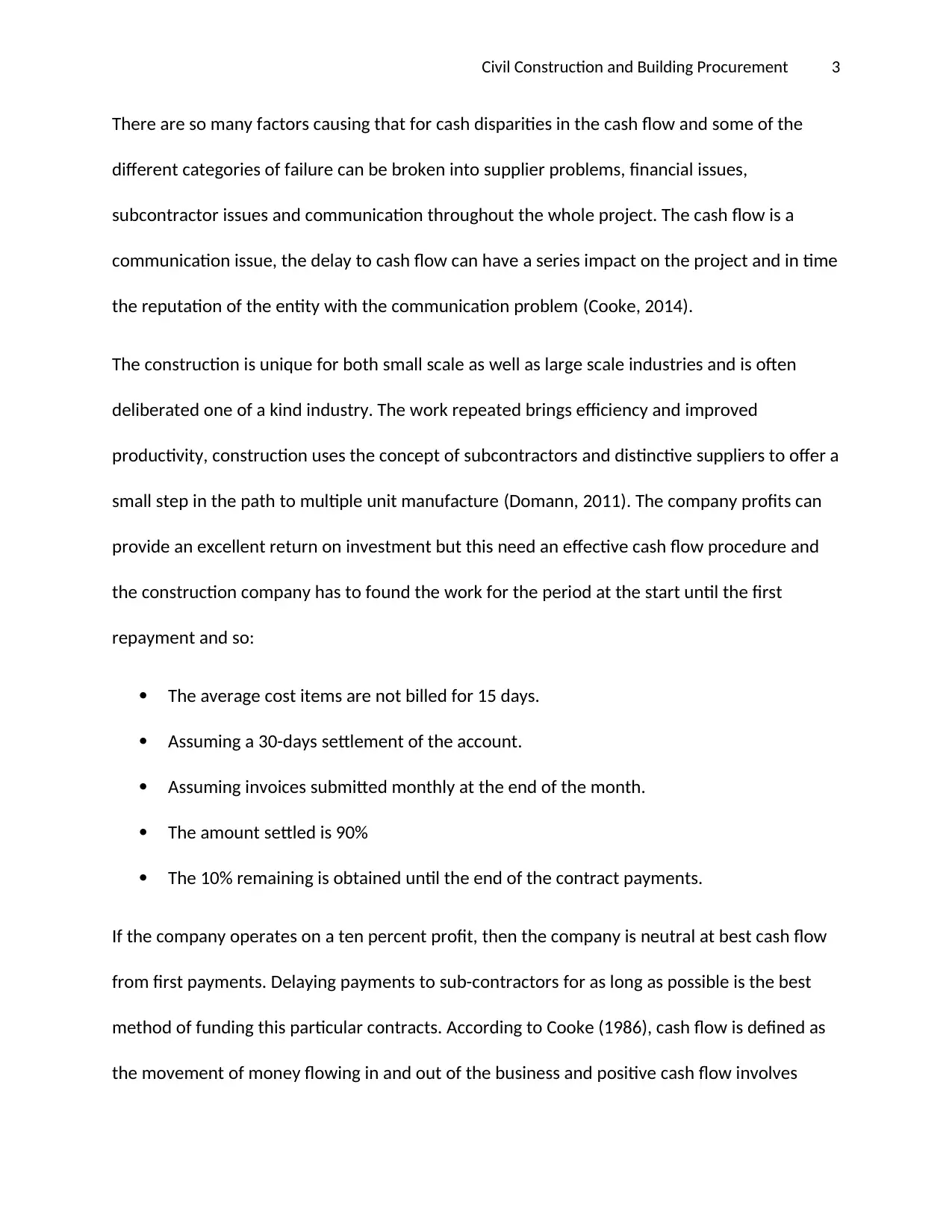
Civil Construction and Building Procurement 3
There are so many factors causing that for cash disparities in the cash flow and some of the
different categories of failure can be broken into supplier problems, financial issues,
subcontractor issues and communication throughout the whole project. The cash flow is a
communication issue, the delay to cash flow can have a series impact on the project and in time
the reputation of the entity with the communication problem (Cooke, 2014).
The construction is unique for both small scale as well as large scale industries and is often
deliberated one of a kind industry. The work repeated brings efficiency and improved
productivity, construction uses the concept of subcontractors and distinctive suppliers to offer a
small step in the path to multiple unit manufacture (Domann, 2011). The company profits can
provide an excellent return on investment but this need an effective cash flow procedure and
the construction company has to found the work for the period at the start until the first
repayment and so:
The average cost items are not billed for 15 days.
Assuming a 30-days settlement of the account.
Assuming invoices submitted monthly at the end of the month.
The amount settled is 90%
The 10% remaining is obtained until the end of the contract payments.
If the company operates on a ten percent profit, then the company is neutral at best cash flow
from first payments. Delaying payments to sub-contractors for as long as possible is the best
method of funding this particular contracts. According to Cooke (1986), cash flow is defined as
the movement of money flowing in and out of the business and positive cash flow involves
There are so many factors causing that for cash disparities in the cash flow and some of the
different categories of failure can be broken into supplier problems, financial issues,
subcontractor issues and communication throughout the whole project. The cash flow is a
communication issue, the delay to cash flow can have a series impact on the project and in time
the reputation of the entity with the communication problem (Cooke, 2014).
The construction is unique for both small scale as well as large scale industries and is often
deliberated one of a kind industry. The work repeated brings efficiency and improved
productivity, construction uses the concept of subcontractors and distinctive suppliers to offer a
small step in the path to multiple unit manufacture (Domann, 2011). The company profits can
provide an excellent return on investment but this need an effective cash flow procedure and
the construction company has to found the work for the period at the start until the first
repayment and so:
The average cost items are not billed for 15 days.
Assuming a 30-days settlement of the account.
Assuming invoices submitted monthly at the end of the month.
The amount settled is 90%
The 10% remaining is obtained until the end of the contract payments.
If the company operates on a ten percent profit, then the company is neutral at best cash flow
from first payments. Delaying payments to sub-contractors for as long as possible is the best
method of funding this particular contracts. According to Cooke (1986), cash flow is defined as
the movement of money flowing in and out of the business and positive cash flow involves
⊘ This is a preview!⊘
Do you want full access?
Subscribe today to unlock all pages.

Trusted by 1+ million students worldwide
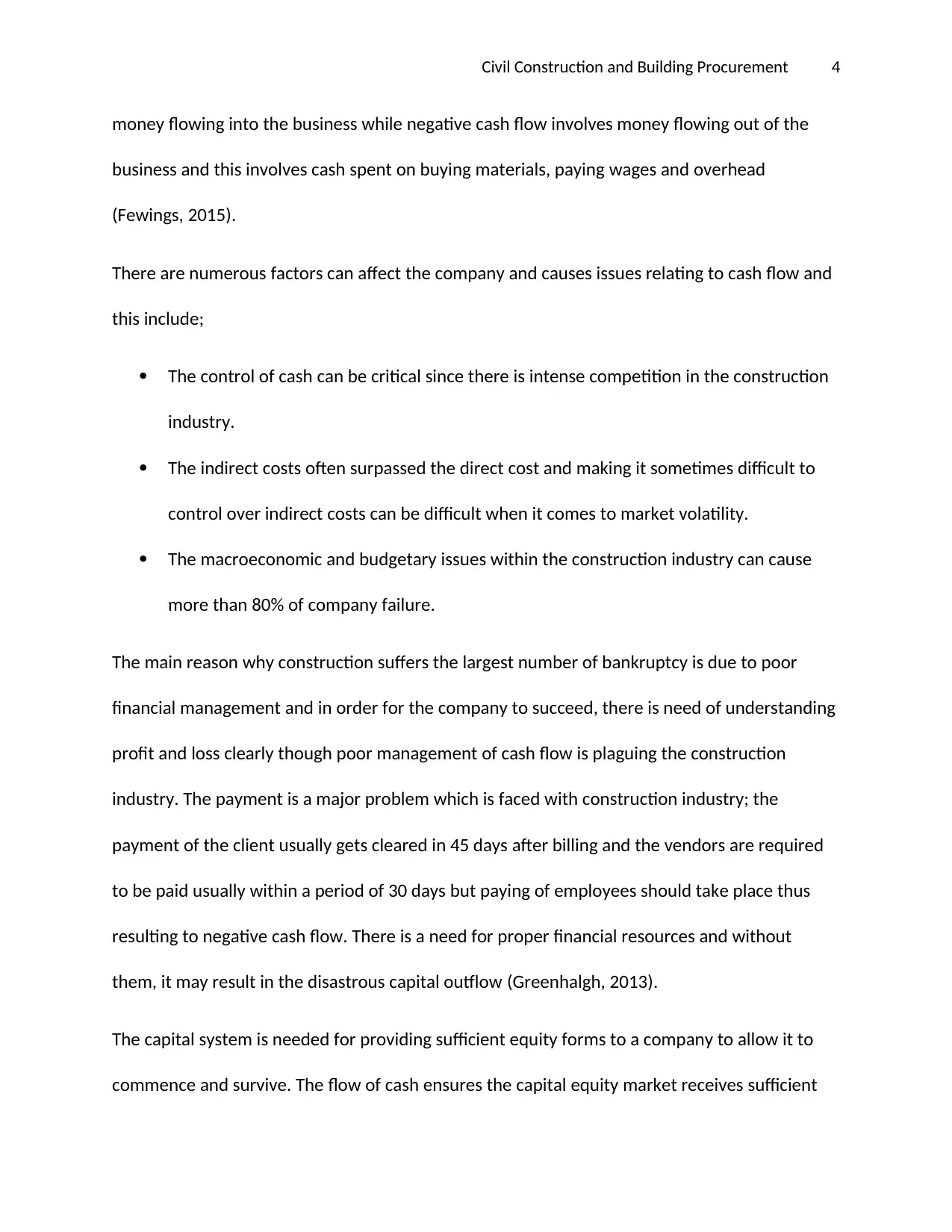
Civil Construction and Building Procurement 4
money flowing into the business while negative cash flow involves money flowing out of the
business and this involves cash spent on buying materials, paying wages and overhead
(Fewings, 2015).
There are numerous factors can affect the company and causes issues relating to cash flow and
this include;
The control of cash can be critical since there is intense competition in the construction
industry.
The indirect costs often surpassed the direct cost and making it sometimes difficult to
control over indirect costs can be difficult when it comes to market volatility.
The macroeconomic and budgetary issues within the construction industry can cause
more than 80% of company failure.
The main reason why construction suffers the largest number of bankruptcy is due to poor
financial management and in order for the company to succeed, there is need of understanding
profit and loss clearly though poor management of cash flow is plaguing the construction
industry. The payment is a major problem which is faced with construction industry; the
payment of the client usually gets cleared in 45 days after billing and the vendors are required
to be paid usually within a period of 30 days but paying of employees should take place thus
resulting to negative cash flow. There is a need for proper financial resources and without
them, it may result in the disastrous capital outflow (Greenhalgh, 2013).
The capital system is needed for providing sufficient equity forms to a company to allow it to
commence and survive. The flow of cash ensures the capital equity market receives sufficient
money flowing into the business while negative cash flow involves money flowing out of the
business and this involves cash spent on buying materials, paying wages and overhead
(Fewings, 2015).
There are numerous factors can affect the company and causes issues relating to cash flow and
this include;
The control of cash can be critical since there is intense competition in the construction
industry.
The indirect costs often surpassed the direct cost and making it sometimes difficult to
control over indirect costs can be difficult when it comes to market volatility.
The macroeconomic and budgetary issues within the construction industry can cause
more than 80% of company failure.
The main reason why construction suffers the largest number of bankruptcy is due to poor
financial management and in order for the company to succeed, there is need of understanding
profit and loss clearly though poor management of cash flow is plaguing the construction
industry. The payment is a major problem which is faced with construction industry; the
payment of the client usually gets cleared in 45 days after billing and the vendors are required
to be paid usually within a period of 30 days but paying of employees should take place thus
resulting to negative cash flow. There is a need for proper financial resources and without
them, it may result in the disastrous capital outflow (Greenhalgh, 2013).
The capital system is needed for providing sufficient equity forms to a company to allow it to
commence and survive. The flow of cash ensures the capital equity market receives sufficient
Paraphrase This Document
Need a fresh take? Get an instant paraphrase of this document with our AI Paraphraser
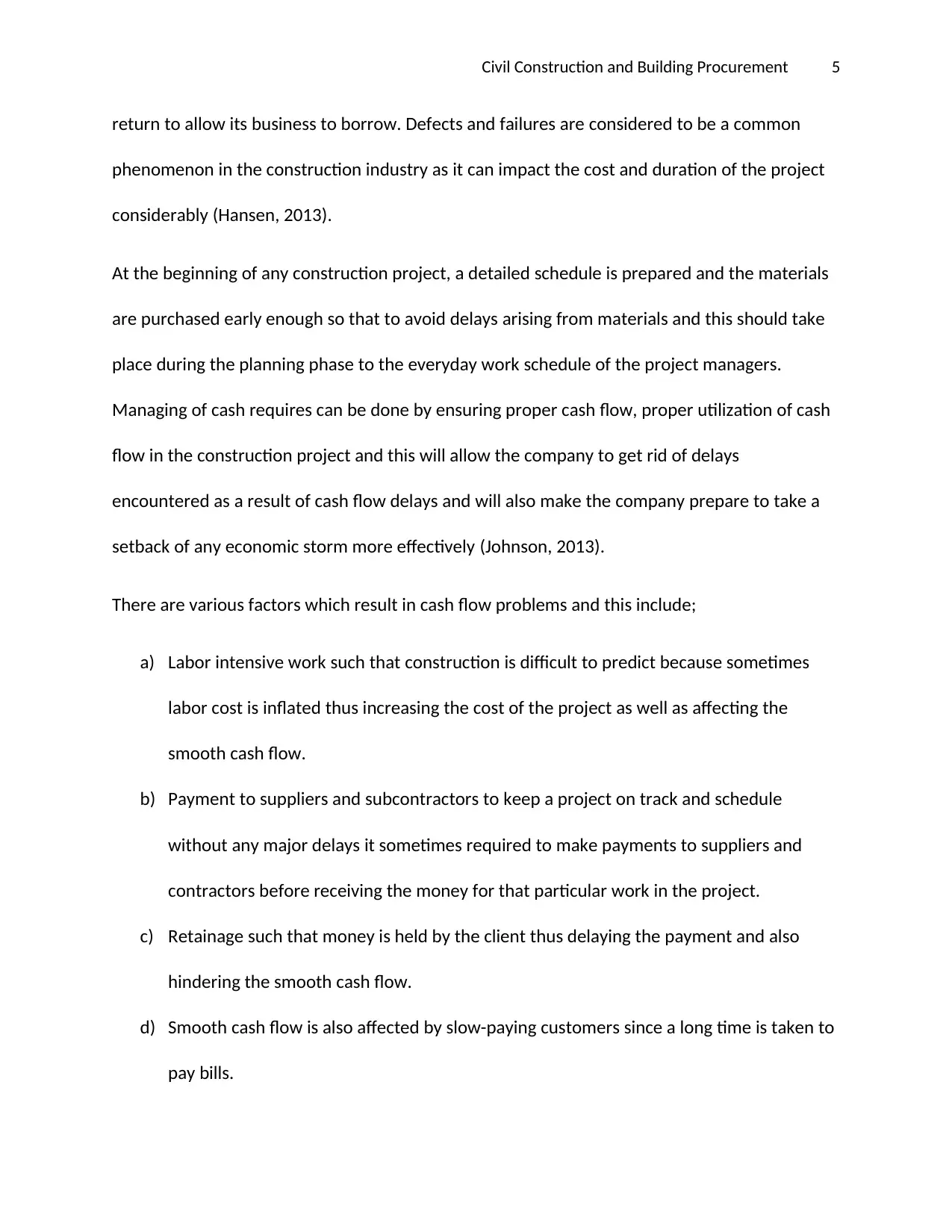
Civil Construction and Building Procurement 5
return to allow its business to borrow. Defects and failures are considered to be a common
phenomenon in the construction industry as it can impact the cost and duration of the project
considerably (Hansen, 2013).
At the beginning of any construction project, a detailed schedule is prepared and the materials
are purchased early enough so that to avoid delays arising from materials and this should take
place during the planning phase to the everyday work schedule of the project managers.
Managing of cash requires can be done by ensuring proper cash flow, proper utilization of cash
flow in the construction project and this will allow the company to get rid of delays
encountered as a result of cash flow delays and will also make the company prepare to take a
setback of any economic storm more effectively (Johnson, 2013).
There are various factors which result in cash flow problems and this include;
a) Labor intensive work such that construction is difficult to predict because sometimes
labor cost is inflated thus increasing the cost of the project as well as affecting the
smooth cash flow.
b) Payment to suppliers and subcontractors to keep a project on track and schedule
without any major delays it sometimes required to make payments to suppliers and
contractors before receiving the money for that particular work in the project.
c) Retainage such that money is held by the client thus delaying the payment and also
hindering the smooth cash flow.
d) Smooth cash flow is also affected by slow-paying customers since a long time is taken to
pay bills.
return to allow its business to borrow. Defects and failures are considered to be a common
phenomenon in the construction industry as it can impact the cost and duration of the project
considerably (Hansen, 2013).
At the beginning of any construction project, a detailed schedule is prepared and the materials
are purchased early enough so that to avoid delays arising from materials and this should take
place during the planning phase to the everyday work schedule of the project managers.
Managing of cash requires can be done by ensuring proper cash flow, proper utilization of cash
flow in the construction project and this will allow the company to get rid of delays
encountered as a result of cash flow delays and will also make the company prepare to take a
setback of any economic storm more effectively (Johnson, 2013).
There are various factors which result in cash flow problems and this include;
a) Labor intensive work such that construction is difficult to predict because sometimes
labor cost is inflated thus increasing the cost of the project as well as affecting the
smooth cash flow.
b) Payment to suppliers and subcontractors to keep a project on track and schedule
without any major delays it sometimes required to make payments to suppliers and
contractors before receiving the money for that particular work in the project.
c) Retainage such that money is held by the client thus delaying the payment and also
hindering the smooth cash flow.
d) Smooth cash flow is also affected by slow-paying customers since a long time is taken to
pay bills.
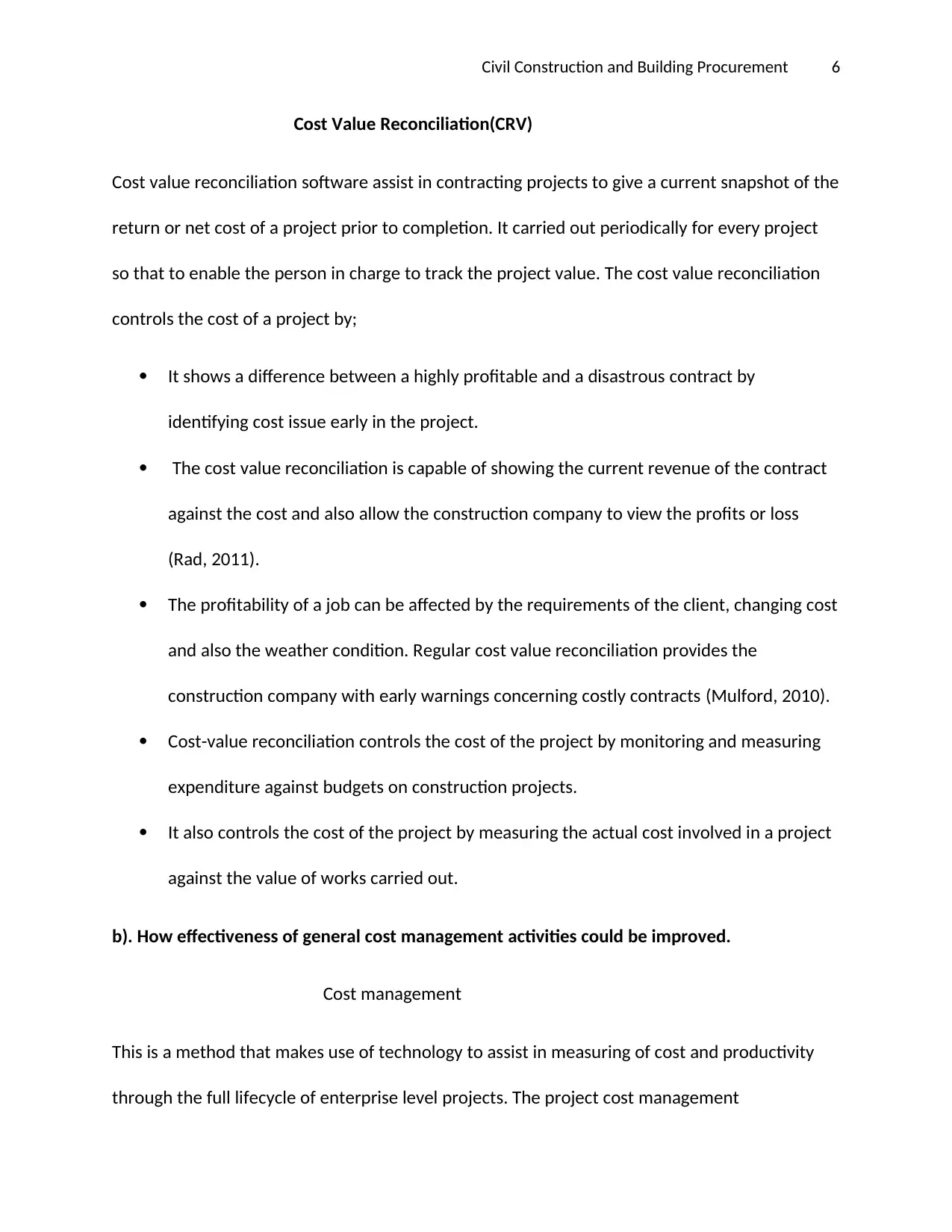
Civil Construction and Building Procurement 6
Cost Value Reconciliation(CRV)
Cost value reconciliation software assist in contracting projects to give a current snapshot of the
return or net cost of a project prior to completion. It carried out periodically for every project
so that to enable the person in charge to track the project value. The cost value reconciliation
controls the cost of a project by;
It shows a difference between a highly profitable and a disastrous contract by
identifying cost issue early in the project.
The cost value reconciliation is capable of showing the current revenue of the contract
against the cost and also allow the construction company to view the profits or loss
(Rad, 2011).
The profitability of a job can be affected by the requirements of the client, changing cost
and also the weather condition. Regular cost value reconciliation provides the
construction company with early warnings concerning costly contracts (Mulford, 2010).
Cost-value reconciliation controls the cost of the project by monitoring and measuring
expenditure against budgets on construction projects.
It also controls the cost of the project by measuring the actual cost involved in a project
against the value of works carried out.
b). How effectiveness of general cost management activities could be improved.
Cost management
This is a method that makes use of technology to assist in measuring of cost and productivity
through the full lifecycle of enterprise level projects. The project cost management
Cost Value Reconciliation(CRV)
Cost value reconciliation software assist in contracting projects to give a current snapshot of the
return or net cost of a project prior to completion. It carried out periodically for every project
so that to enable the person in charge to track the project value. The cost value reconciliation
controls the cost of a project by;
It shows a difference between a highly profitable and a disastrous contract by
identifying cost issue early in the project.
The cost value reconciliation is capable of showing the current revenue of the contract
against the cost and also allow the construction company to view the profits or loss
(Rad, 2011).
The profitability of a job can be affected by the requirements of the client, changing cost
and also the weather condition. Regular cost value reconciliation provides the
construction company with early warnings concerning costly contracts (Mulford, 2010).
Cost-value reconciliation controls the cost of the project by monitoring and measuring
expenditure against budgets on construction projects.
It also controls the cost of the project by measuring the actual cost involved in a project
against the value of works carried out.
b). How effectiveness of general cost management activities could be improved.
Cost management
This is a method that makes use of technology to assist in measuring of cost and productivity
through the full lifecycle of enterprise level projects. The project cost management
⊘ This is a preview!⊘
Do you want full access?
Subscribe today to unlock all pages.

Trusted by 1+ million students worldwide
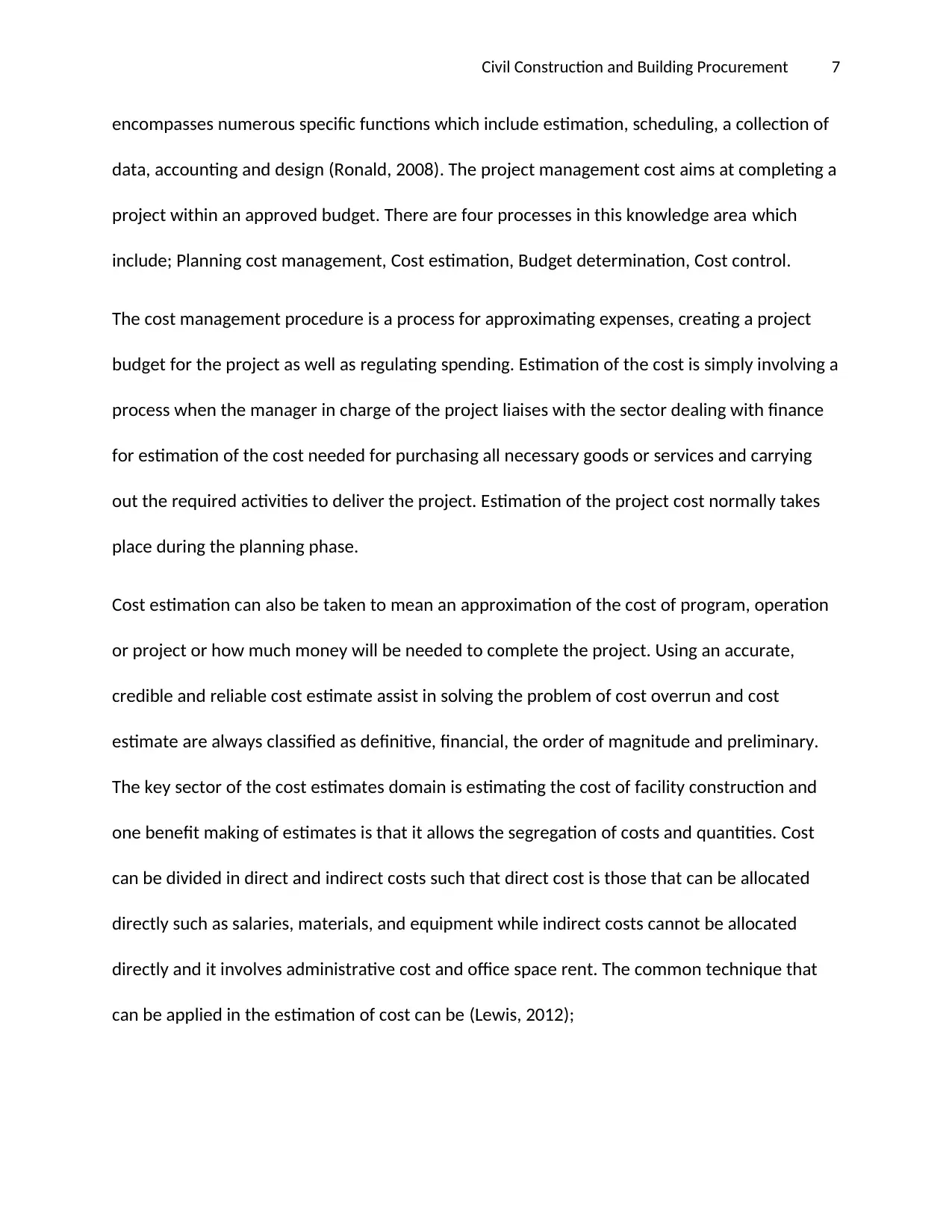
Civil Construction and Building Procurement 7
encompasses numerous specific functions which include estimation, scheduling, a collection of
data, accounting and design (Ronald, 2008). The project management cost aims at completing a
project within an approved budget. There are four processes in this knowledge area which
include; Planning cost management, Cost estimation, Budget determination, Cost control.
The cost management procedure is a process for approximating expenses, creating a project
budget for the project as well as regulating spending. Estimation of the cost is simply involving a
process when the manager in charge of the project liaises with the sector dealing with finance
for estimation of the cost needed for purchasing all necessary goods or services and carrying
out the required activities to deliver the project. Estimation of the project cost normally takes
place during the planning phase.
Cost estimation can also be taken to mean an approximation of the cost of program, operation
or project or how much money will be needed to complete the project. Using an accurate,
credible and reliable cost estimate assist in solving the problem of cost overrun and cost
estimate are always classified as definitive, financial, the order of magnitude and preliminary.
The key sector of the cost estimates domain is estimating the cost of facility construction and
one benefit making of estimates is that it allows the segregation of costs and quantities. Cost
can be divided in direct and indirect costs such that direct cost is those that can be allocated
directly such as salaries, materials, and equipment while indirect costs cannot be allocated
directly and it involves administrative cost and office space rent. The common technique that
can be applied in the estimation of cost can be (Lewis, 2012);
encompasses numerous specific functions which include estimation, scheduling, a collection of
data, accounting and design (Ronald, 2008). The project management cost aims at completing a
project within an approved budget. There are four processes in this knowledge area which
include; Planning cost management, Cost estimation, Budget determination, Cost control.
The cost management procedure is a process for approximating expenses, creating a project
budget for the project as well as regulating spending. Estimation of the cost is simply involving a
process when the manager in charge of the project liaises with the sector dealing with finance
for estimation of the cost needed for purchasing all necessary goods or services and carrying
out the required activities to deliver the project. Estimation of the project cost normally takes
place during the planning phase.
Cost estimation can also be taken to mean an approximation of the cost of program, operation
or project or how much money will be needed to complete the project. Using an accurate,
credible and reliable cost estimate assist in solving the problem of cost overrun and cost
estimate are always classified as definitive, financial, the order of magnitude and preliminary.
The key sector of the cost estimates domain is estimating the cost of facility construction and
one benefit making of estimates is that it allows the segregation of costs and quantities. Cost
can be divided in direct and indirect costs such that direct cost is those that can be allocated
directly such as salaries, materials, and equipment while indirect costs cannot be allocated
directly and it involves administrative cost and office space rent. The common technique that
can be applied in the estimation of cost can be (Lewis, 2012);
Paraphrase This Document
Need a fresh take? Get an instant paraphrase of this document with our AI Paraphraser
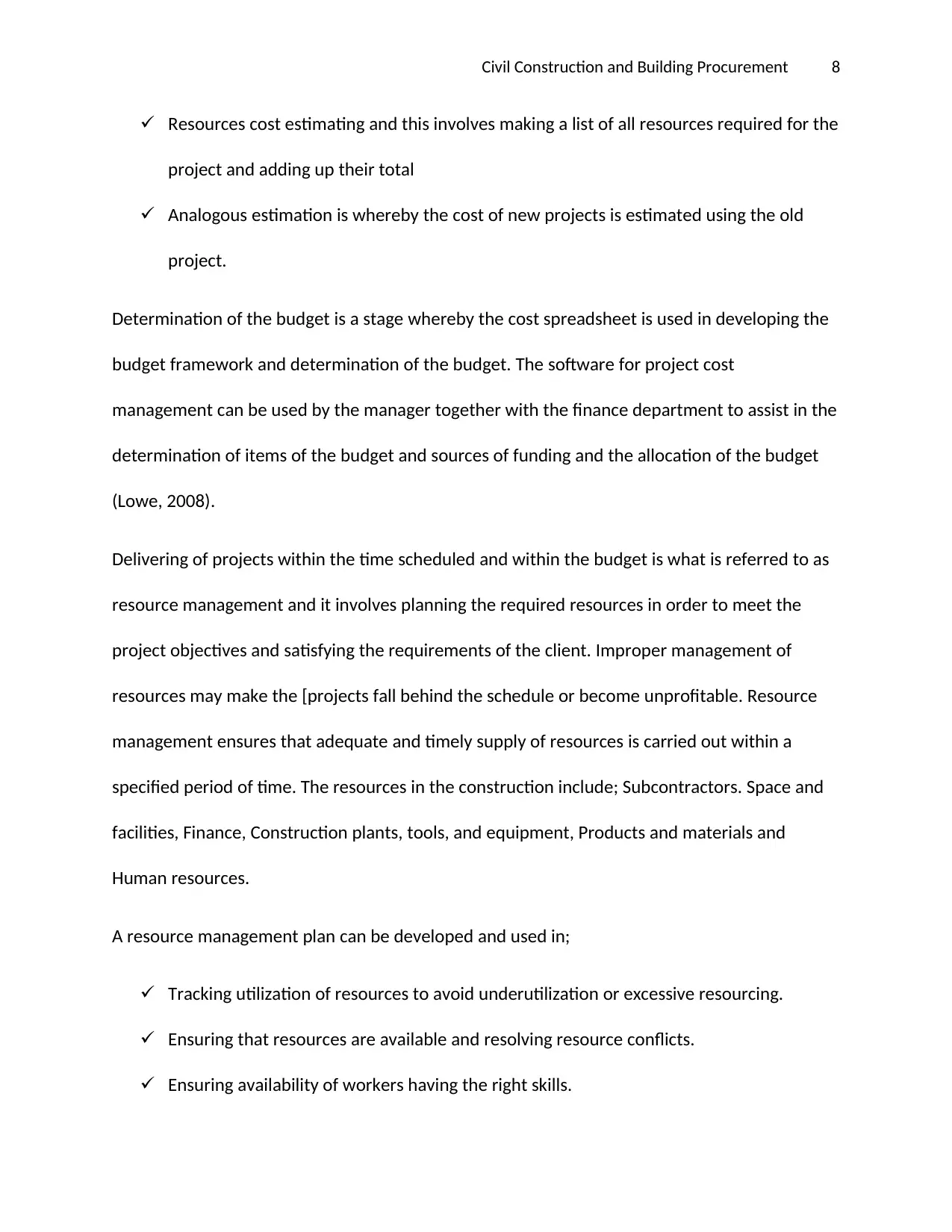
Civil Construction and Building Procurement 8
Resources cost estimating and this involves making a list of all resources required for the
project and adding up their total
Analogous estimation is whereby the cost of new projects is estimated using the old
project.
Determination of the budget is a stage whereby the cost spreadsheet is used in developing the
budget framework and determination of the budget. The software for project cost
management can be used by the manager together with the finance department to assist in the
determination of items of the budget and sources of funding and the allocation of the budget
(Lowe, 2008).
Delivering of projects within the time scheduled and within the budget is what is referred to as
resource management and it involves planning the required resources in order to meet the
project objectives and satisfying the requirements of the client. Improper management of
resources may make the [projects fall behind the schedule or become unprofitable. Resource
management ensures that adequate and timely supply of resources is carried out within a
specified period of time. The resources in the construction include; Subcontractors. Space and
facilities, Finance, Construction plants, tools, and equipment, Products and materials and
Human resources.
A resource management plan can be developed and used in;
Tracking utilization of resources to avoid underutilization or excessive resourcing.
Ensuring that resources are available and resolving resource conflicts.
Ensuring availability of workers having the right skills.
Resources cost estimating and this involves making a list of all resources required for the
project and adding up their total
Analogous estimation is whereby the cost of new projects is estimated using the old
project.
Determination of the budget is a stage whereby the cost spreadsheet is used in developing the
budget framework and determination of the budget. The software for project cost
management can be used by the manager together with the finance department to assist in the
determination of items of the budget and sources of funding and the allocation of the budget
(Lowe, 2008).
Delivering of projects within the time scheduled and within the budget is what is referred to as
resource management and it involves planning the required resources in order to meet the
project objectives and satisfying the requirements of the client. Improper management of
resources may make the [projects fall behind the schedule or become unprofitable. Resource
management ensures that adequate and timely supply of resources is carried out within a
specified period of time. The resources in the construction include; Subcontractors. Space and
facilities, Finance, Construction plants, tools, and equipment, Products and materials and
Human resources.
A resource management plan can be developed and used in;
Tracking utilization of resources to avoid underutilization or excessive resourcing.
Ensuring that resources are available and resolving resource conflicts.
Ensuring availability of workers having the right skills.
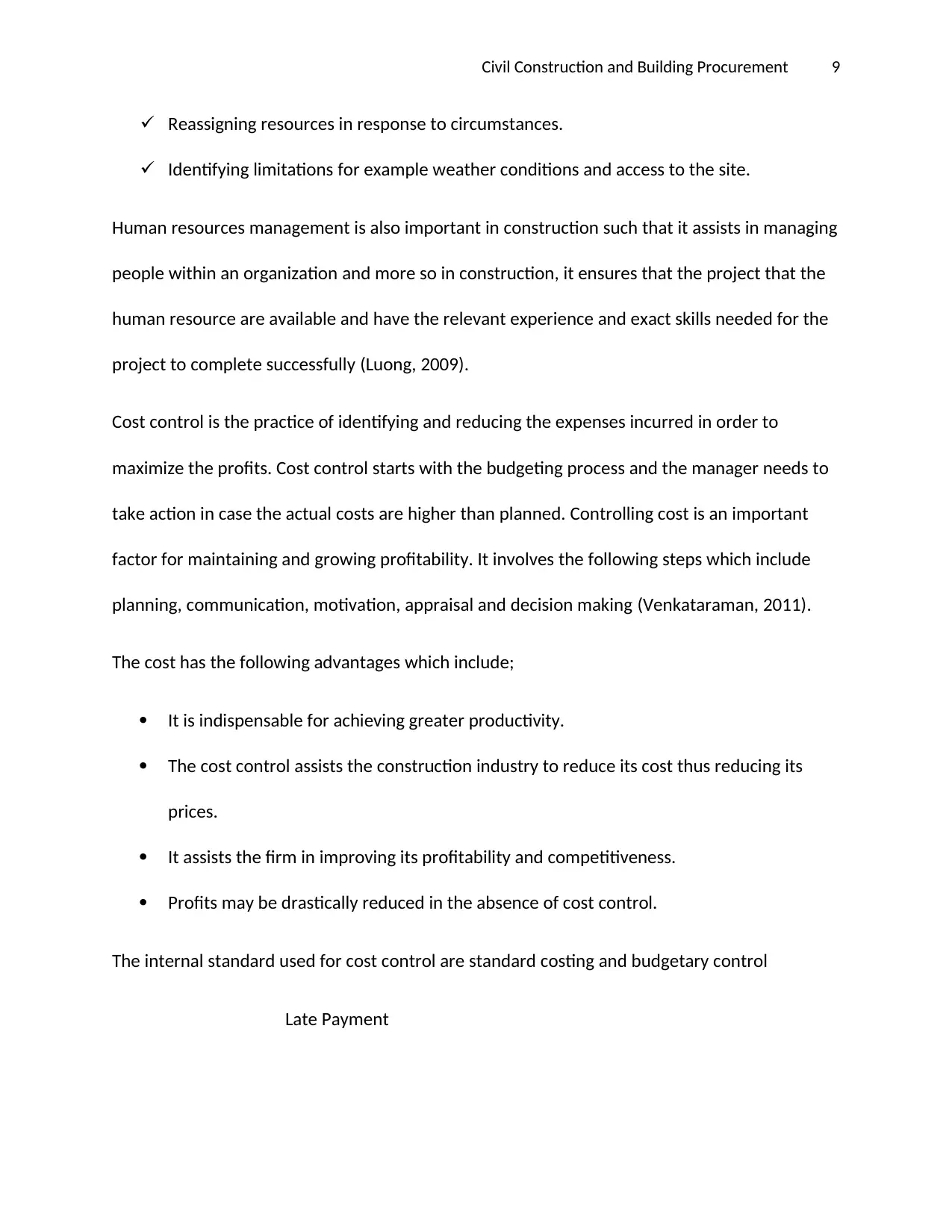
Civil Construction and Building Procurement 9
Reassigning resources in response to circumstances.
Identifying limitations for example weather conditions and access to the site.
Human resources management is also important in construction such that it assists in managing
people within an organization and more so in construction, it ensures that the project that the
human resource are available and have the relevant experience and exact skills needed for the
project to complete successfully (Luong, 2009).
Cost control is the practice of identifying and reducing the expenses incurred in order to
maximize the profits. Cost control starts with the budgeting process and the manager needs to
take action in case the actual costs are higher than planned. Controlling cost is an important
factor for maintaining and growing profitability. It involves the following steps which include
planning, communication, motivation, appraisal and decision making (Venkataraman, 2011).
The cost has the following advantages which include;
It is indispensable for achieving greater productivity.
The cost control assists the construction industry to reduce its cost thus reducing its
prices.
It assists the firm in improving its profitability and competitiveness.
Profits may be drastically reduced in the absence of cost control.
The internal standard used for cost control are standard costing and budgetary control
Late Payment
Reassigning resources in response to circumstances.
Identifying limitations for example weather conditions and access to the site.
Human resources management is also important in construction such that it assists in managing
people within an organization and more so in construction, it ensures that the project that the
human resource are available and have the relevant experience and exact skills needed for the
project to complete successfully (Luong, 2009).
Cost control is the practice of identifying and reducing the expenses incurred in order to
maximize the profits. Cost control starts with the budgeting process and the manager needs to
take action in case the actual costs are higher than planned. Controlling cost is an important
factor for maintaining and growing profitability. It involves the following steps which include
planning, communication, motivation, appraisal and decision making (Venkataraman, 2011).
The cost has the following advantages which include;
It is indispensable for achieving greater productivity.
The cost control assists the construction industry to reduce its cost thus reducing its
prices.
It assists the firm in improving its profitability and competitiveness.
Profits may be drastically reduced in the absence of cost control.
The internal standard used for cost control are standard costing and budgetary control
Late Payment
⊘ This is a preview!⊘
Do you want full access?
Subscribe today to unlock all pages.

Trusted by 1+ million students worldwide
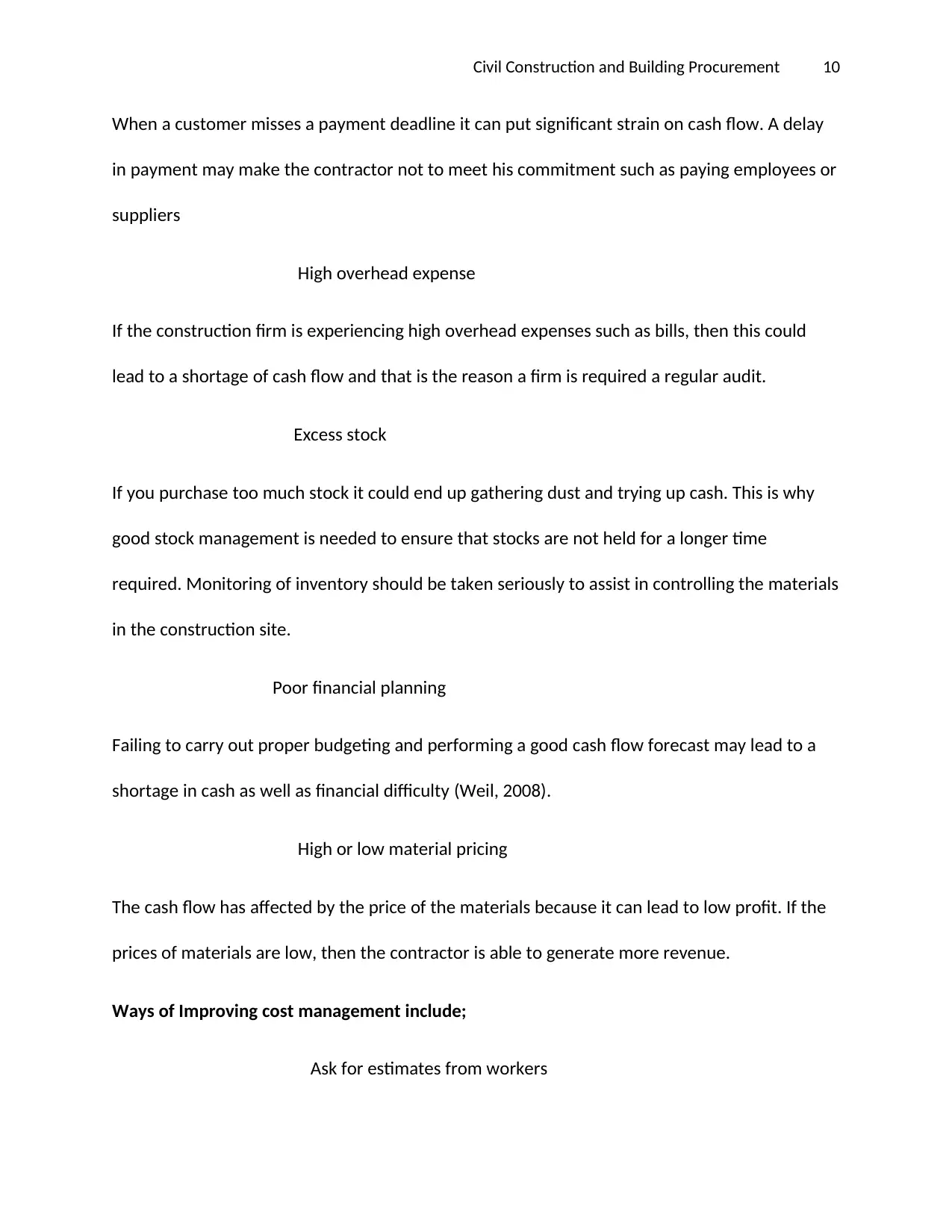
Civil Construction and Building Procurement 10
When a customer misses a payment deadline it can put significant strain on cash flow. A delay
in payment may make the contractor not to meet his commitment such as paying employees or
suppliers
High overhead expense
If the construction firm is experiencing high overhead expenses such as bills, then this could
lead to a shortage of cash flow and that is the reason a firm is required a regular audit.
Excess stock
If you purchase too much stock it could end up gathering dust and trying up cash. This is why
good stock management is needed to ensure that stocks are not held for a longer time
required. Monitoring of inventory should be taken seriously to assist in controlling the materials
in the construction site.
Poor financial planning
Failing to carry out proper budgeting and performing a good cash flow forecast may lead to a
shortage in cash as well as financial difficulty (Weil, 2008).
High or low material pricing
The cash flow has affected by the price of the materials because it can lead to low profit. If the
prices of materials are low, then the contractor is able to generate more revenue.
Ways of Improving cost management include;
Ask for estimates from workers
When a customer misses a payment deadline it can put significant strain on cash flow. A delay
in payment may make the contractor not to meet his commitment such as paying employees or
suppliers
High overhead expense
If the construction firm is experiencing high overhead expenses such as bills, then this could
lead to a shortage of cash flow and that is the reason a firm is required a regular audit.
Excess stock
If you purchase too much stock it could end up gathering dust and trying up cash. This is why
good stock management is needed to ensure that stocks are not held for a longer time
required. Monitoring of inventory should be taken seriously to assist in controlling the materials
in the construction site.
Poor financial planning
Failing to carry out proper budgeting and performing a good cash flow forecast may lead to a
shortage in cash as well as financial difficulty (Weil, 2008).
High or low material pricing
The cash flow has affected by the price of the materials because it can lead to low profit. If the
prices of materials are low, then the contractor is able to generate more revenue.
Ways of Improving cost management include;
Ask for estimates from workers
Paraphrase This Document
Need a fresh take? Get an instant paraphrase of this document with our AI Paraphraser
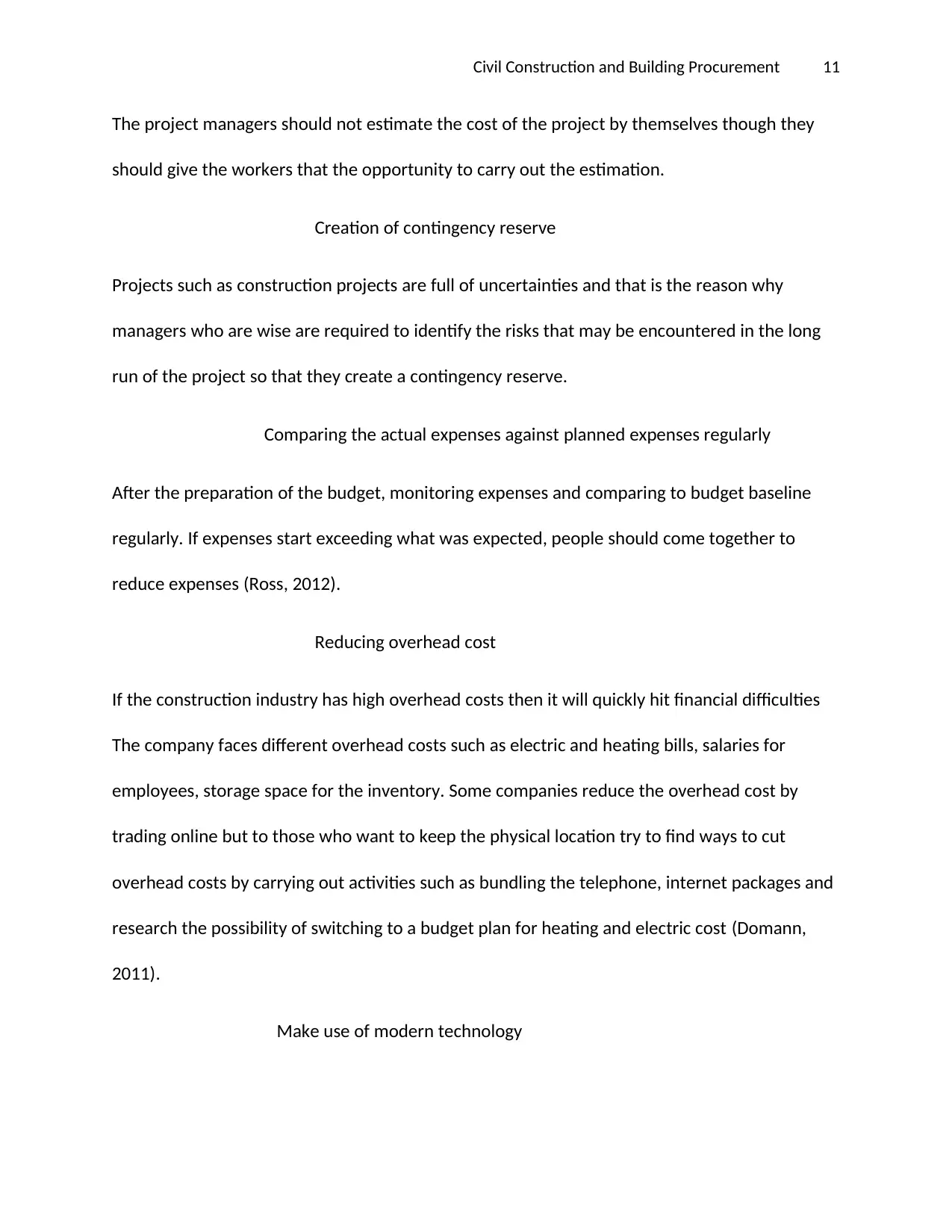
Civil Construction and Building Procurement 11
The project managers should not estimate the cost of the project by themselves though they
should give the workers that the opportunity to carry out the estimation.
Creation of contingency reserve
Projects such as construction projects are full of uncertainties and that is the reason why
managers who are wise are required to identify the risks that may be encountered in the long
run of the project so that they create a contingency reserve.
Comparing the actual expenses against planned expenses regularly
After the preparation of the budget, monitoring expenses and comparing to budget baseline
regularly. If expenses start exceeding what was expected, people should come together to
reduce expenses (Ross, 2012).
Reducing overhead cost
If the construction industry has high overhead costs then it will quickly hit financial difficulties
The company faces different overhead costs such as electric and heating bills, salaries for
employees, storage space for the inventory. Some companies reduce the overhead cost by
trading online but to those who want to keep the physical location try to find ways to cut
overhead costs by carrying out activities such as bundling the telephone, internet packages and
research the possibility of switching to a budget plan for heating and electric cost (Domann,
2011).
Make use of modern technology
The project managers should not estimate the cost of the project by themselves though they
should give the workers that the opportunity to carry out the estimation.
Creation of contingency reserve
Projects such as construction projects are full of uncertainties and that is the reason why
managers who are wise are required to identify the risks that may be encountered in the long
run of the project so that they create a contingency reserve.
Comparing the actual expenses against planned expenses regularly
After the preparation of the budget, monitoring expenses and comparing to budget baseline
regularly. If expenses start exceeding what was expected, people should come together to
reduce expenses (Ross, 2012).
Reducing overhead cost
If the construction industry has high overhead costs then it will quickly hit financial difficulties
The company faces different overhead costs such as electric and heating bills, salaries for
employees, storage space for the inventory. Some companies reduce the overhead cost by
trading online but to those who want to keep the physical location try to find ways to cut
overhead costs by carrying out activities such as bundling the telephone, internet packages and
research the possibility of switching to a budget plan for heating and electric cost (Domann,
2011).
Make use of modern technology
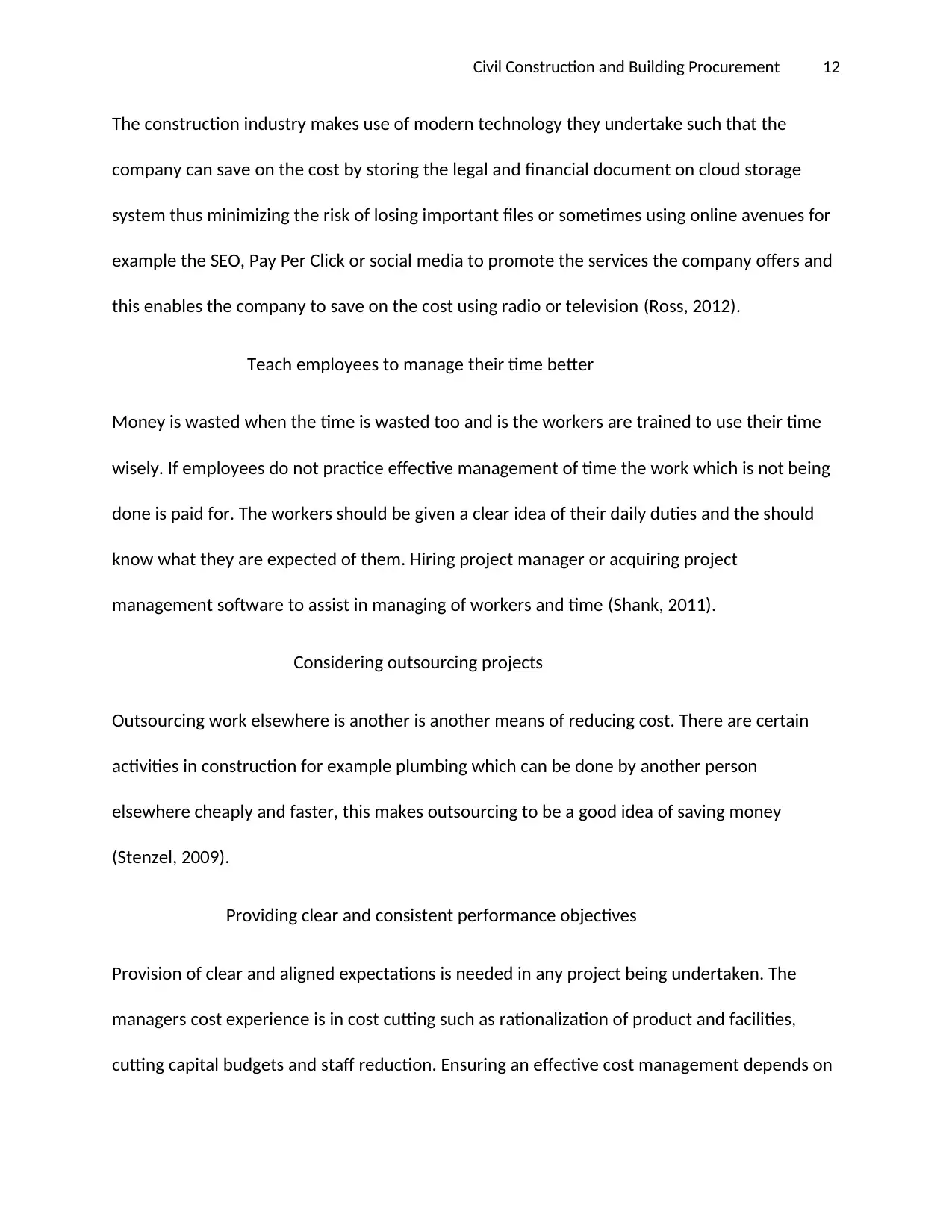
Civil Construction and Building Procurement 12
The construction industry makes use of modern technology they undertake such that the
company can save on the cost by storing the legal and financial document on cloud storage
system thus minimizing the risk of losing important files or sometimes using online avenues for
example the SEO, Pay Per Click or social media to promote the services the company offers and
this enables the company to save on the cost using radio or television (Ross, 2012).
Teach employees to manage their time better
Money is wasted when the time is wasted too and is the workers are trained to use their time
wisely. If employees do not practice effective management of time the work which is not being
done is paid for. The workers should be given a clear idea of their daily duties and the should
know what they are expected of them. Hiring project manager or acquiring project
management software to assist in managing of workers and time (Shank, 2011).
Considering outsourcing projects
Outsourcing work elsewhere is another is another means of reducing cost. There are certain
activities in construction for example plumbing which can be done by another person
elsewhere cheaply and faster, this makes outsourcing to be a good idea of saving money
(Stenzel, 2009).
Providing clear and consistent performance objectives
Provision of clear and aligned expectations is needed in any project being undertaken. The
managers cost experience is in cost cutting such as rationalization of product and facilities,
cutting capital budgets and staff reduction. Ensuring an effective cost management depends on
The construction industry makes use of modern technology they undertake such that the
company can save on the cost by storing the legal and financial document on cloud storage
system thus minimizing the risk of losing important files or sometimes using online avenues for
example the SEO, Pay Per Click or social media to promote the services the company offers and
this enables the company to save on the cost using radio or television (Ross, 2012).
Teach employees to manage their time better
Money is wasted when the time is wasted too and is the workers are trained to use their time
wisely. If employees do not practice effective management of time the work which is not being
done is paid for. The workers should be given a clear idea of their daily duties and the should
know what they are expected of them. Hiring project manager or acquiring project
management software to assist in managing of workers and time (Shank, 2011).
Considering outsourcing projects
Outsourcing work elsewhere is another is another means of reducing cost. There are certain
activities in construction for example plumbing which can be done by another person
elsewhere cheaply and faster, this makes outsourcing to be a good idea of saving money
(Stenzel, 2009).
Providing clear and consistent performance objectives
Provision of clear and aligned expectations is needed in any project being undertaken. The
managers cost experience is in cost cutting such as rationalization of product and facilities,
cutting capital budgets and staff reduction. Ensuring an effective cost management depends on
⊘ This is a preview!⊘
Do you want full access?
Subscribe today to unlock all pages.

Trusted by 1+ million students worldwide
1 out of 14
Related Documents
Your All-in-One AI-Powered Toolkit for Academic Success.
+13062052269
info@desklib.com
Available 24*7 on WhatsApp / Email
![[object Object]](/_next/static/media/star-bottom.7253800d.svg)
Unlock your academic potential
Copyright © 2020–2025 A2Z Services. All Rights Reserved. Developed and managed by ZUCOL.





